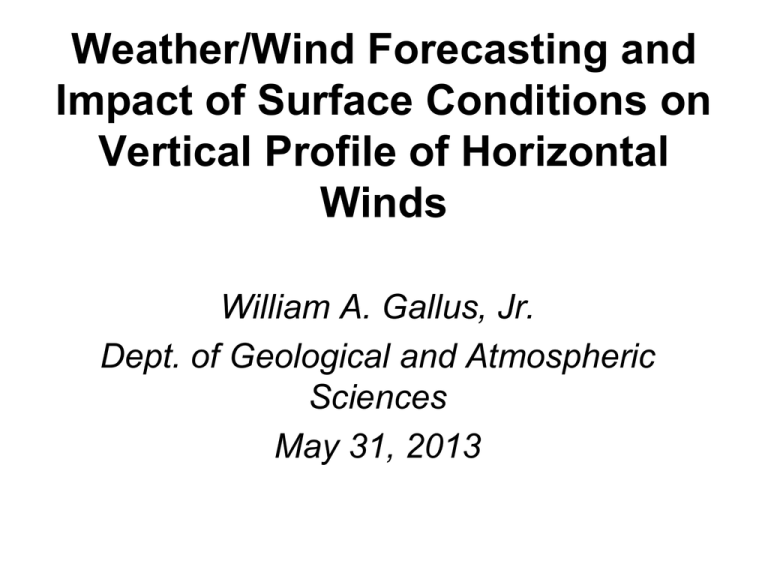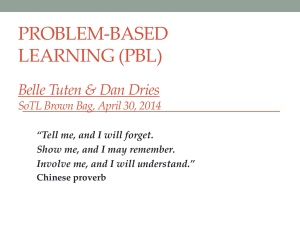Mixed Layer Growth
advertisement

Weather/Wind Forecasting and Impact of Surface Conditions on Vertical Profile of Horizontal Winds William A. Gallus, Jr. Dept. of Geological and Atmospheric Sciences May 31, 2013 How might you forecast the weather (or wind in particular)? Several Methods can be used: • Climatology – just assume winds will behave like they normally do at this location, time of year, and time of day • Statistical – fit observed data using multiple regression, automated neural networks, etc. • Numerical models (Numerical Weather Prediction) Climatology • Ramp events, very difficult to forecast, can sometimes be best predicted using climatology. • Winds tend to follow seasonal and diurnal trends (reasons to be explained later) –> near the ground they are strongest during the day and weakest at night. Several hundred meters up, behavior can be opposite. Not fully understood which way they will behave around turbine height of 80 m Both types of ramps show two peaks during the year. One in May/June corresponds to active period for Low-Level jets and also thunderstorms. Other is in Dec/Jan. Ramp ups increase sharply to peak in evening (6-9 pm) with minimum in early morning (6-9 am). Ramp downs have peak in early morning (6-9 am) with very pronounced minimum in mid-day hours (9am-3pm). Statistical Approaches • Can be applied to both observations and model output to look for relationships/correlations. Doesn’t have to make obvious sense. You might find that a prediction of wind 2 hrs from now is most accurate if an equation is used based on phase of the moon, score of recent Cubs game, etc! Statistical Approaches • Traditionally, in operational forecasting, MOS (Model Output Statistics) is used to refine NWP model output to improve predictions of surface temperature, dew point, and winds. Otherwise, statistical approaches are often avoided by scientists as being “black box”, but they can yield the very best forecasts. These approaches, e.g. MOS, can make use of the other 2: raw NWP output, climatological trends Numerical Weather Prediction Models • How can you use equations to predict the weather? Numerical Weather Prediction Models • How can you use equations to predict the weather? • If you have an equation that involves a d/dt, like du/dt = A + B + C, then you can predict the future (you know how the variable, like wind, changes with respect to time) Can you think of an equation that would allow us to predict future wind? Can you think of an equation that would allow us to predict future wind? F = ma a = dV/dt So dV/dt = F/m How do you think we can solve such an equation? Numerical Weather Prediction Models • Weather forecasting models are generally built on the Navier-Stokes equations, which come from the basic laws of physics. • These equations are usually discretized, typically via finite differencing, and because they are prognostic equations, they can then predict the future (one time step at a time) • For wind speed prediction, the forecasting equations of interest derive from F=ma. We can re-arrange to write a=F/m, which can yield component equations: Du/Dt = F/m Dv/Dt = F/m Dw/Dt = F/m But, we usually like to forecast at a fixed point (Eulerian framework) instead of in a Lagrangian sense, so we expand the total derivative • We thus have equations that look like: ∂u/∂t = -v∇u - w∂u/∂z = F/m • For horizontal winds (u and v), the forces of importance on the right-hand side include pressure-gradient force, Coriolis force, and Friction. The friction contribution is mostly from the ground. • Pressure gradients are the one force that really “creates” wind. Temperature changes can lead to pressure changes, and thus affect the winds • Coriolis Force (f k x V) just changes the direction of wind (directed to the right in Northern Hemisphere) • Friction ends up being a challenge to treat in the models Other considerations for NWP • Where do you make your predictions (which kind of horizontal and vertical grid do you use)? w T,u,v T,u,v T v T T,u,v u T u v w T • How exactly do you “discretize” the equations? ut+1 = ut + ▲t – ut (ut, i+1- ut, i-1) /▲x - … ut+1 = ut-1 + 2▲t – (ut, i+1- ut, i) /▲x … or • How do you treat atmospheric processes that are too small to be depicted on your grid? Parameterizations are used – and these can vary greatly. Often used for convection, microphysics (cloud physics), turbulence, radiation, land-surface interaction, soil processes…. • When we solve equations like these in a numerical forecast model, however, we are really solving for averages (both spatial and temporal) Reynolds Averaging • Any variable b at any point in space-time can be expressed as a mean and a perturbation: b= b + b’ • The average of perturbations is 0 = b’ • Statistics are stationary over averaging interval So, if we apply these rules, our equation for u-momentum looks like: ∂u/∂t + ∂u’/∂t = -(u∂u/∂x + u’∂u/∂x +u∂u’/∂x +u’∂u’/∂x) – v….. But averages of single primed terms are 0, so this becomes… ∂u/∂t = -(u∂u/∂x + u’∂u’/∂x) – (v…. Here, the first term is advection of mean wind by mean wind. • Second term is net (mean) contribution from advection of wind fluctuations by the fluctuating part of the wind. These fluctuations are often referred to as “turbulence” but this is not strictly correct – they include ALL fluctuations on scales smaller than the grid volume. • If we look at the sub-grid scale transport terms in more detail, we can use the product rule of differentiation and rearrange to show that • ∂u/∂t = -u∂u/∂x -∂/∂x(u’u’) - u’∂u’/∂x Where the second term is recognizable as “turbulence flux divergence” (or sub-grid) Last term can be re-written and shown to equal zero assuming incompressible continuity Closure Issue • Our entire set of governing equations then ends up consisting of 7 equations, with 7 first-moment variables (u,v,w,Θ,ρ,p,T – all of these having overbars on them), but we have ended up with 8 second-moment unknowns from the averaging procedure. • If we make more predictive equations for the second moments, we don’t fix the problem, because we then end up with additional terms involving the third moment [like ∂/∂x(u’u’u’) ]. • We cannot close the system by adding equations for the higher-order terms. To obtain a closed system, we have to do something about the higher-order terms. Obtaining a closed system • We can either ignore higher-order terms • Or…represent them as a function of lowerorder variables First-order closure • For first-order closure, used in almost all forecasting models, we have equations to predict the first-order moments, and we represent higher-order moments as a function of the first-order ones. Gradient-transfer theory • Most common approach to first-order closure is called gradient-transfer theory. We represent fluxes as proportional to gradients of mean variables: u’b’ = -K ∂b/∂x So, subgrid flux in a given direction is proportional to gradient in that direction, and transport is down-gradient (from high values of b toward low ones) • Also, transport depends on the LOCAL GRADIENT (∂b/∂x) • The K terms can be anisotropic, meaning we could have different values for horizontal versus vertical transport Specification of Ks • We can use profile methods – specify some function giving realistic distribution of K with height, so that it is small near ground, large in lower half of Planetary Boundary Layer (PBL), and smaller again near top of PBL • Local stability/mixing length – K’s are specified by some functional form so they are small where atmosphere is stable and increase as atmosphere becomes less stable Mixing Length (cont) • These schemes specify a “mixing length”. A “law of the wall” type approach is used so that l -> 0 at the ground (l=kz) where k=von Karman’s constant (around 0.4). An upper bound is placed on k so that l< l0 of roughly 50-100 m • A widely-recognized deficiency in gradienttransfer theory is that sometimes fluxes do not depend on local gradients. Convective eddies in daytime PBL transport heat across the entire PBL depth (from ground to top), and this transport is related more to bulk PBL properties than local gradients. It is possible to try to include some of these non-local effects. PBL (Mixed Layer) Growth • Definition – layer of the atmosphere having its behavior directly affected by the surface • The PBL typically grows deeper during the day as the sun warms the ground, and rapidly collapses at night Potential temperature is a concept often used to depict the PBL –> θ = T (1000/p)R/cp β=∂θ/∂z zi Z PBL heat The layer with uniform potential temperature is referred to as the mixed layer (or PBL), and its top is usually denoted zi (where “i” stands for “inversion”) • The redistribution of air parcels corresponds to a heat flux. We represent the kinematic heat flux as w’’θ’’, i.e., correlations of turbulent vertical motions with turbulent fluctuations of temperature. • The heat flux warms the temperature and deepens the PBL • A deeper PBL generally means that higherspeed winds from higher levels in the atmosphere are “mixed” down to the region near the surface (and vice-versa… frictionslowed air is mixed upward) Land use/characteristics impact the PBL • How much friction is a function of the characteristics of the earth’s surface • Lots of trees/hills/tall buildings lead to lots of friction and slowing of flow • Cold water or snow prevents warming and thermals, confining friction to layer right near ground, without much PBL development • Things get really interesting as the sun is getting ready to set • Cooling first happens near the ground, so a stable layer forms there, and this “decouples” the atmosphere from the surface. Friction now has very little impact on the air in the lower atmosphere. Remnant PBL Stable layer • Removal of friction allows the air a short distance above the ground (50-1000 m) to begin accelerating, with speeds increasing and directions veering (clockwise) • Coriolis force leads to an “inertial oscillation” so that winds peak in speed around 1 or 2 am => Low Level Jet PBL parameterizations in models – example from WRF • Non-local: 1) ACM2 (or Pleim) 2) YSU • Local: 1) MYJ 2) QNSE 3) MYNN2.5 4) MYNN3.0 Biases in 80m wind forecasts using different PBL schemes in WRF model Note: YSU is most different Composites of PBL biases by hour. Each line represents a different PBL scheme; MYJ (Black), MYNN 2.5 (Red), MYNN 3.0 (Blue), Pleim or ACM2 (Green), QNSE (Cyan), and YSU (Magenta). Differences in predictions of Low-Level Jets from one case using WRF model Observed peak Wind speed as a function of height profile during the LLJ peak on March 24, 2009 at 10pm LST. Black dots represent observations from the 915-mHz wind profiler while each line represents a different PBL scheme; MYJ (Black), MYNN 2.5 (Cyan), MYNN 3.0 (Magenta), Pleim or ACM2 (Red), QNSE (Blue), and YSU (Green). Three hour averaged diurnal cycle of ramp-up events using the midpoint of the ramp event. Black line is observed ramp-up events. Note the very different behavior of the YSU scheme, and to a lesser extent the Pleim Example of challenges of creating a good NWP forecast system for Wind Based on M.S. work of Adam Deppe (Deppe et al. 2013 Wea. Forecasting paper) NWP Model (WRF) was run over these 2 domains/grid spacings Which would you think should give the best forecast and why??? Model domain and location of verification data Figure 2. (Left) The 10 km domain with outline of Pomeroy wind farm (right) where the individual wind turbines are the black dots and the 80 m meteorological tower (observed data location) is the X. Table 2. MAE associated with six PBL schemes using the 00 UTC time initialization and the GFS ILBC from 10 cases in January 2010. The six member ensemble average and the standard deviation (measure of model spread) are also listed. PBL Scheme MAE ( m s-1) MYJ 1.38 -1 (ms ) MYNN 2.5 1.43 -1 (ms ) MYNN 3.0 1.38 -1 (ms ) Pleim 1.29 -1 (ms ) QNSE 1.39 -1 (ms ) YSU 1.31 -1 (ms ) Ensemble 1.26 -1 (ms ) Note the ensemble (average) does the best Standard Deviation ------------0.66 Table 3. MAE associated with three different GFS perturbations using the YSU and MYNN3.0 PBL schemes from 10 cases in January 2010. The two member ensemble average and the standard deviation (measure of model spread) are also listed. Perturbation Number MYNN 3.0 MAE ( m s-1) YSU MAE ( m s-1) Ensemble MAE ( m s-1) 2 4 15 Standard Deviation 1.88 1.73 1.80 --- 1.60 1.59 1.72 --- 1.58 1.53 1.62 0.98 The spread (variety) has increased but not the skill (MAE not reduced) so this is not a good solution Table 4. MAE associated with the wind speed at 80 m from two different grid spacings (4 km and 10 km) from 10 cases in January 2010. The two member ensemble average is also listed. Grid Spacing MYNN 3.0 MAE ( m s-1) YSU MAE ( m s-1) Ensemble MAE ( m s-1) 10 km 1.37 1.29 1.18 4 km 1.70 1.33 1.27 For this domain and cases, the 4 km model domain did not work as well. Ideas why? Table 5. MAE associated with the wind speed at 80 m from three different initialization times from 10 cases in January 2010. The two member ensemble average and the standard deviation (measure of model spread) are also listed. Time Initialization MYNN 3.0 MAE ( m s-1) YSU MAE ( m s-1) Ensemble MAE ( m s-1) 18 UTC 00 UTC 06 UTC Standard Deviation 1.42 1.37 1.38 --- 1.32 1.29 1.61 --- 1.23 1.18 1.28 1.09 Different time initializations lead to lower skill AND higher spread 1 2 3 4 5 6 7 Table 6. MAE calculated for the first 24 hour period. The three PBL schemes with the lowest MAE were chosen, making up the Day 2 selected ensemble. Times selected indicate s the number of times a model was chosen as a member of the Day 2 selected ensemble. The nonselected ensemble incorporated the least accurate models for the first 24 hour period. Day 2 All Member Ensemble incorporated all six model members. Model Number 00 UTC MYJ GFS with a 10 km grid spacing 00 UTC MYJ NAM with a 10 km grid spacing 00 UTC Pleim NAM with a 10 km grid spacing 00 UTC Pleim GFS with a 10 km grid spacing 00 UTC YSU NAM with a 10 km grid spacing 00 UTC YSU GFS with a 10 km grid spacing Day 1 MAE ( m s-1) Times selected 2.51 5 2.61 6 2.58 4 2.36 9 2.32 11 2.37 10 Ensemble Mean 1.97 Day 2 selected ensemble best MAE 5/15 Day 2 non-selected ensemble best MAE 4/15 Day 2 All Member Ensemble best MAE 6/15 1 Table 7. MAE for wind speed at 80 m associated with the neighborhood approach. Grid Averaging MYNN3.0 MAE ( m s-1) YSU MAE ( m s-1) Ensemble MAE( m s-1) Point 1.37 1.29 1.18 3x3 1.36 1.28 1.17 5x5 1.36 1.25 1.16 11x11 1.38 1.18 1.14 17x17 1.39 1.16 1.13 21x21 1.40 1.17 1.14 2 Postprocessing via neighborhood approach takes a lot of computer power, but is not improving the forecast very much 1 2 3 Table 8. MAE associated with different bias corrections developed for each PBL scheme for the 00 UTC GFS ILBC. This case study was done from 11 October 2008 to 11 November 2008. Bias Corrections MYJ (m s-1) MYNN 2.5 (m s-1) MYNN 3.0 (m s-1) Pleim (m s-1) QNSE (m s-1) YSU (m s-1) Ensemble (m s-1) No Bias 2.34 2.49 2.41 2.36 2.45 2.28 2.27 Diurnal Cycle 2.29 2.33 2.28 2.27 2.30 2.21 2.18 Wind Direction 2.27 2.27 2.26 2.29 2.28 2.24 2.17 Wind Speed and Direction 2.15 2.16 2.14 2.17 2.17 2.10 2.05 Wind Speed 2.05 2.04 2.01 2.09 2.07 1.99 1.97 Best Improvement 0.29 m s-1 – Wind Speed 0.45 m s-1 – Wind Speed 0.40 m s-1 – Wind Speed 0.27 m s-1 – Wind Speed 0.38 m s-1 – Wind Speed 0.29 m s-1 – Wind Speed 0.30 m s-1 – Wind Speed % of Improvement 14.1% 22.1% 20.0% 13.0% 18.4% 14.6% 15.2% 4 1 1 2 Table 10. Parameterization combinations used in the final OP ensemble to forecast wind speed at 80 m. Land Layer Scheme Initial Boundary Conditions Pleim-Xiu Pleim-Xiu GFS 18 UTC Pleim-Xiu Pleim-Xiu NAM ACM2 00 UTC Pleim-Xiu Pleim-Xiu GFS 4 YSU 00 UTC Noah MoninObukhov NAM 5 YSU 00 UTC Noah MoninObukhov GFS Noah Janjic Eta MoninObukhov GFS Member Number PBL Scheme 1 ACM2 18 UTC 2 ACM2 3 6 3 MYJ Time Land Surface Initialization Scheme 00 UTC 1 2 3 4 5 6 7 8 9 10 11 Table 11. MAE of final OP ensemble after wind speed bias correction compared to other six member ensembles tested for 25 cases during the summer and fall of 2010. The deterministic forecast is the best individual model found from the period studied. Standard devia tion (measure of model spread) for each ensemble is also calculated. The bold value indicates a high level of statistical improvement from the non-bias corrected six member ensembles/deterministic forecast to the non-bias corrected final OP ensemble, with p-values less than 0.1 determined from a Wilcoxon signed -rank test . The italics value indicates a high level of statistical improvement from the non-bias corrected six member ensembles/deterministic forecast to the bias corrected final OP ensemble, with p-values less than 0.1 determined from a Wilcoxon signed-rank test. Ensemble MAE after Bias Correction ( m s-1) MAE Prior to Bias Correction ( m s-1) Standard Deviation after Correction ( m s-1) GFS 00 UTC 1.67 1.99 0.74 GFS 18 UTC 1.66 2.05 0.80 NAM 00 UTC 1.68 1.91 0.67 NAM 18 UTC 1.70 1.93 0.73 Deterministic Forecast 1.70 1.77 --- Final OP Ensemble 1.52 1.67 0.98 1 2 3 4 5 6 7 Table 12. Number of ramp events during Day 1 (06-30 hours after model start up) and Day 2 (30-54 hours after model start up) and model error associated with ramp events for each PBL scheme. Probability of Detection (POD), False Alarm Rate (FAR) and Threat Score were calculated. The Bias and MAE show the timing error associated with each PBL scheme. A hit means the model correctly predicted the ramp event within +/- 6 hours. Bold values indicate best POD, FAR, and TS scores while underlined values indicate worst POD, FAR, and TS scores. PBL Scheme Ramp Type Obs. Total Events Model Total Events Hits False Alarm Miss MAE (hr) Bias (hr) POD FAR TS MYJ Up (Day 1) 35 23 17 6 18 3.47 -1.24 0.49 0.26 0.41 Up (Day 2) 37 17 13 4 24 1.85 -1.23 0.35 0.32 0.32 Down (Day 1) 31 20 8 12 23 1.88 0.63 0.26 0.60 0.19 Down (Day 2) 35 19 12 7 23 1.42 -0.42 0.34 0.37 0.29 Up (Day 1) 35 29 19 10 16 2.68 -1.74 0.54 0.34 0.42 Up (Day 2) 37 25 15 10 22 2.33 -1.20 0.41 0.40 0.32 Down (Day 1) 31 28 11 17 20 1.64 -0.73 0.35 0.61 0.23 Down (Day 2) 35 22 11 11 24 1.55 -0.27 0.31 0.50 0.24 Up (Day 1) 35 27 17 10 18 2.88 -1.71 0.49 0.37 0.38 Up (Day 2) 37 24 16 8 21 2.75 -1.13 0.43 0.33 0.36 Down (Day 1) 31 21 9 12 22 1.89 -0.56 0.29 0.57 0.21 Down (Day 2) 35 16 8 8 27 1.50 0.25 0.23 0.50 0.19 Up (Day 1) 35 19 10 9 25 3.10 -1.30 0.29 0.47 0.23 Up (Day 2) 37 17 12 5 25 2.33 -1.83 0.32 0.29 0.29 Down (Day 1) 31 14 9 5 22 2.22 0.44 0.29 0.36 0.25 Down (Day 2) 35 20 12 8 23 2.00 0.50 0.34 0.40 0.28 Up (Day 1) 35 26 18 8 17 3.56 -2.56 0.51 0.31 0.42 Up (Day 2) 37 26 15 11 22 1.73 -1.20 0.41 0.42 0.31 Down (Day 1) 31 28 11 17 20 1.27 -1.00 0.35 0.61 0.23 Down (Day 2) 35 23 12 11 23 1.33 -0.22 0.34 0.48 0.26 Up (Day 1) 35 16 8 8 27 3.25 -0.25 0.23 0.50 0.19 Up (Day 2) 37 11 8 3 29 2.50 0.25 0.22 0.27 0.20 Down (Day 1) 31 13 9 4 22 1.33 -0.22 0.29 0.31 0.26 Down (Day 2) 35 11 9 2 26 1.33 -0.89 0.26 0.18 0.24 MYNN 2.5 MYNN 3.0 Pleim QNSE YSU Persistence Ups: POD .38 FAR .61 TS .24 Downs: POD .33 FAR .61 TS .21 Summary • Multiple approaches can be used to predict wind • NWP with finite differencing of NavierStokes equations dominates meteorology • Surface friction plays major role on what winds will be like at turbine height many challenges in this region • Multiple ways to parameterize this (PBL schemes) but all have shortcomings






